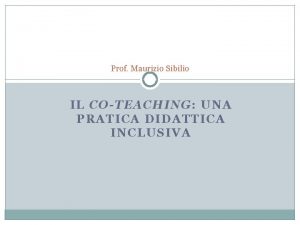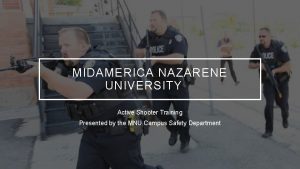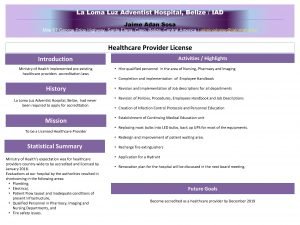CoTeaching Training Point Loma Nazarene University Point Loma




















- Slides: 20

Co-Teaching Training Point Loma Nazarene University

Point Loma Nazarene University • Our vision: • To be a nationally prominent Christian university and a leading voice in higher education and the church—known for excellence in academic preparation, wholeness in personal development, & faithfulness to mission. • Our core values: • • A global perspective and experience Excellence in teaching and learning The development of students as whole persons An intentionally Christian community

Point Loma Nazarene University • Our mission: • PLNU exists to provide higher education in a vital Christian community where minds are engaged and challenged, character is modeled and formed, and service becomes an expression of faith. equip - transform - empower

PLNU Teacher Candidates have. . . • Completed foundational and methodological courses specific to pursued credential(s) • Observed 80+ hours in a classroom • Obtained a Certificate of Clearance or equivalent • Passed the CBEST • Passed the CSET

Co-Teaching Basics

Co-Teaching Defined Co-teaching is defined as two teachers (the cooperating teacher and the teacher candidate) working together with groups of students and sharing the planning, organization, delivery and assessment of instruction, as well as the physical space. Both teachers are actively involved and engaged in all aspects of instruction.

“The basic purpose of any student teaching program is to provide a situation in which student teachers learn and practice varied techniques of teaching while working with real students under the direction of a certified teacher in a public school. ” Wentz, 2001

Co-Teaching Basics • The cooperating teacher and teacher candidate are both prepared. Together, they attend a pairs training to assist them in relationship building, communication, collaboration, and co-planning to co-teach. • The teacher candidate and cooperating teacher plan lessons together throughout the experience. The cooperating teacher leads early on and the teacher candidate takes the lead as time progresses.

Co-Teaching Basics • The teacher candidate begins teaching the first day of the experience, using co-teaching strategies learned at the pairs training. • The cooperating teacher provides modeling and coaching, making the invisible by explicitly sharing their rationale for instructional, curricular and management decisions. Through co-planning and coteaching, the cooperating teacher allows the teacher candidate time to develop and practice strategies with help and support.

Key Elements • Training/Preparation • Co-teaching training • Forms training • Pairs training • Collaborative partnerships • Common language • Clearly-defined expectations, including solo/lead teaching time for candidates • Designated planning time for co-teaching

Co-Teaching Benefits Teacher Candidate Benefits • Being seen as a “real” teacher • Equal partnership • Sharing resources • Mutual support and learning Cooperating Teacher Benefits • Ability to do projects more successfully • More productive class time • Modeling and participating in teamwork • Candidates become competent more quickly

Co-Teaching Strategies

One Teach, One Observe One teacher has primary instructional responsibility while the other gathers specific observational information on students or the instructing teacher.

One Teach, One Assist One teacher has primary instructional responsibility while the other assists students with their work, monitors behaviors, or corrects assignments.

Station Teaching The co-teaching pair divide the instructional content into two parts. Each teacher instructs one group and then switches, or groups spend a designated amount of time at each station.

Parallel Teaching In this approach, each teacher instructs half the students. The two teachers are addressing the same instructional material using the same teaching strategies.

Supplemental Teaching This strategy allows one teacher to work with students at their expected grade level, while the other teacher works with those students who need the information and/or materials extended or remediated.

Alternative/Differentiated Teaching Alternative teaching strategies provide two different approaches to teaching the same information. The learning outcome is the same for all students; however, the avenue for getting there is different.

Team Teaching Well-planned, team-taught lessons exhibit an invisible flow of instruction with no prescribed division of authority. Both teachers are actively involved in the lesson. From a student’s perspective, there is no clearly-defined leader. Both teachers share the instruction, are free to interject information, and are available to assist students and answer questions.

What Does Co-Teaching Look Like? • Teacher candidates will be expected to. . . • Contribute ideas from the very beginning of the experience • Engage with students and assist with their learning from the very first day • Take on full leadership in planning, instruction and assessment • Demonstrate competencies as a teacher • Have opportunities to teach alone
 Coteaching
Coteaching Coteaching
Coteaching American nazarene university
American nazarene university Korea nazarene university
Korea nazarene university Nazarene nurses training college washim
Nazarene nurses training college washim Nazarene clergy development
Nazarene clergy development Articles of faith nazarene
Articles of faith nazarene Que cali es cali señores lo demas es loma
Que cali es cali señores lo demas es loma Loma linda earthquake 1989
Loma linda earthquake 1989 Luma luz
Luma luz Snellov zakon loma
Snellov zakon loma Loma rica lions club
Loma rica lions club Loma prieta
Loma prieta Loma linda irb
Loma linda irb Laminectomy wayne
Laminectomy wayne 沈榮麟
沈榮麟 Gat training
Gat training Dbhdd policystat
Dbhdd policystat Training is expensive without training it is more expensive
Training is expensive without training it is more expensive Metode of the job training
Metode of the job training Aggression replacement training facilitator training
Aggression replacement training facilitator training




































